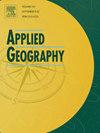利用可解释的多视点时空图神经网络探索城市环境语义用于空气质量预测
IF 4
2区 地球科学
Q1 GEOGRAPHY
引用次数: 0
摘要
准确的空气质量预报对城市管理和公共卫生至关重要,但由于空气污染时空动态的复杂性以及静态和动态城市因素的相互作用,它仍然具有挑战性。传统模型往往忽略静态城市驱动因素的影响,如建筑环境特征,这对理解污染模式至关重要。针对这一限制,我们提出了一个多视图、多模态的时空图神经网络(STGNN)框架,该框架将动态污染数据与静态城市环境语义集成在一起,以提高预测性能和可解释性。通过在图结构中嵌入静态特征,如兴趣点(poi),并利用自关注机制,我们的模型捕获了复杂的空间依赖关系和时间动态。此外,集成的解释器模块通过揭示驱动空气质量预测的空间和特征级影响来提高透明度。实验结果表明,与基准模型相比,我们的方法不仅实现了更高的预测精度,而且还为城市特征与空气质量之间的关系提供了可操作的见解。这项研究强调了整合多模式数据和可解释性在推进空气质量预测中的重要性,为城市规划和污染缓解战略提供了有价值的启示。本文章由计算机程序翻译,如有差异,请以英文原文为准。
Exploring urban environmental semantics for air quality prediction using explainable multi-view spatiotemporal graph neural networks
Accurate air quality forecasting is essential for urban management and public health, yet it remains challenging due to the complexity of spatiotemporal air pollution dynamics and the interplay of static and dynamic urban factors. Traditional models often neglect the influence of static urban drivers, such as built environment features, which are critical to understanding pollution patterns. Addressing this limitation, we propose a multi-view, multi-modal Spatio-Temporal Graph Neural Network (STGNN) framework that integrates dynamic pollution data with static urban environmental semantics to improve predictive performance and interpretability. By embedding static features, such as Points of Interest (POIs), into the graph structure and leveraging a self-attention mechanism, our model captures complex spatial dependencies and temporal dynamics. Furthermore, an integrated Explainer module enhances transparency by revealing the spatial and feature-level influences driving air quality predictions. Experimental results demonstrate that our approach not only achieves superior predictive accuracy compared to benchmark models but also provides actionable insights into the relationships between urban features and air quality. This study highlights the importance of integrating multi-modal data and interpretability in advancing air quality prediction, offering valuable implications for urban planning and pollution mitigation strategies.
求助全文
通过发布文献求助,成功后即可免费获取论文全文。
去求助
来源期刊

Applied Geography
GEOGRAPHY-
CiteScore
8.00
自引率
2.00%
发文量
134
期刊介绍:
Applied Geography is a journal devoted to the publication of research which utilizes geographic approaches (human, physical, nature-society and GIScience) to resolve human problems that have a spatial dimension. These problems may be related to the assessment, management and allocation of the world physical and/or human resources. The underlying rationale of the journal is that only through a clear understanding of the relevant societal, physical, and coupled natural-humans systems can we resolve such problems. Papers are invited on any theme involving the application of geographical theory and methodology in the resolution of human problems.
 求助内容:
求助内容: 应助结果提醒方式:
应助结果提醒方式:


